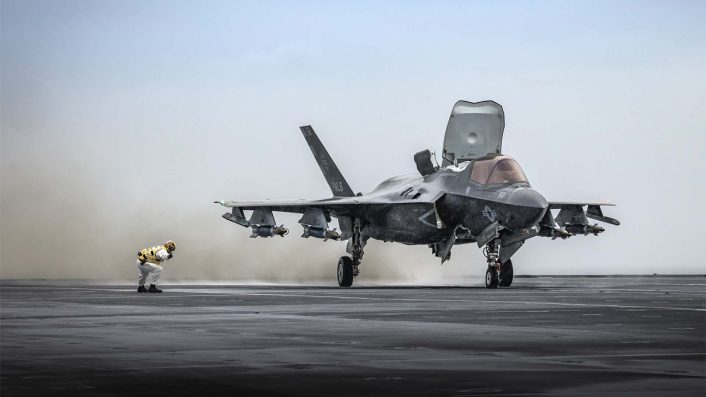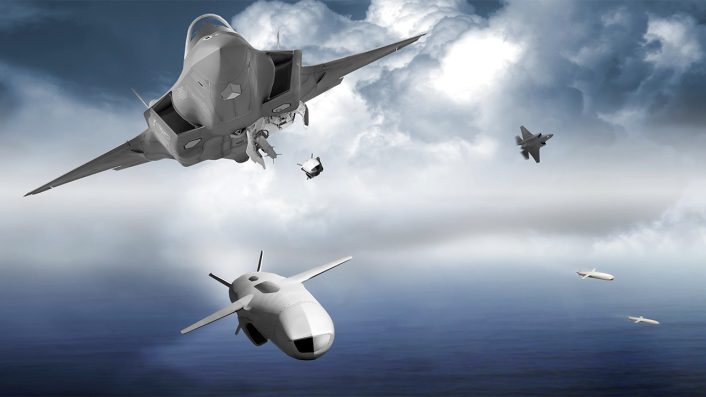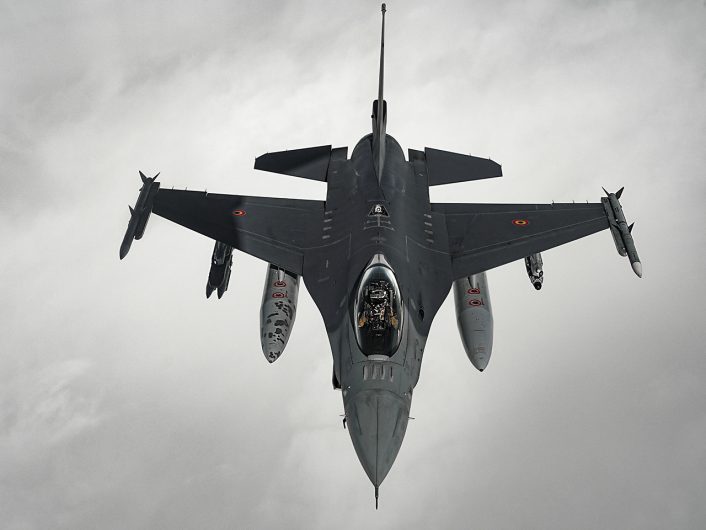The now planned purchase of F-35As, which will join the NATO nuclear mission, has led headlines, but the UK’s F-35Bs still lack any standoff strike weapons.
As UK carrier strike approaches the declaration of full operating capability (FOC) with the planned simultaneous deployment of 24 UK F-35Bs on board HMS Prince of Wales, it is notable that, even six years after being declared combat ready, the UK Lightning Force’s only option when it comes to actually striking targets is the Paveway IV guided bomb.
Though Paveway IV, which uses the 500 lb Mark 82 bomb as a base, is a very capable weapon featuring dual mode GPS and laser guidance, it is nonetheless still a gravity bomb with a limited range. To deliver Paveway IVs on a target, an aircraft must approach to within 15 to 18 miles, well within the reach of even short-range air defense missiles. The F-35, as an aircraft built from the ground up to be stealthy, is more suited to this type of mission than most, but it still places the aircraft and its pilot at greater risk.

The F-35 Block 4 upgrade is intended to herald a wave of new weapons integrations, including the Meteor air to air missile as well as the UK’s SPEAR 3 (Select Precision Effects At Range Capability 3) missile. SPEAR 3 is intended to include a small 90-100 kg multi-mode air to surface missile as well as the SPEAR EW with an electronic warfare payload. However, though flight trials of this missile are underway on the Eurofighter Typhoon, integration onto the F-35B is not expected until at least 2028 and potentially even later. Integration of UK weapons onto F-35B is a hotly debated topic – with integration managed by the U.S., UK weapons are fairly low on the priority list.
Even when F-35B gains the SPEAR missile, the relatively small size of the weapon limits it to a smaller warhead and a maximum range between 80 and 100 miles. It will be a welcome addition to the UK’s stockpile both for the F-35B and for Typhoon, but it still leaves capability gaps for carrier strike.


Storm Shadow, which has been fielded by the Typhoon FGR4 since the retirement of the RAF’s Tornado GR4s, is not planned for integration on F-35B. Though the weapon is currently the UK’s premier long range strike weapon, this is somewhat understandable as Storm Shadow itself is intended to be replaced by the mid 2030s through the UK-France Future Cruise/Anti-Ship Weapon (FC/ASW) collaborative program. However, under current proposals there is no public plan to integrate FC/ASW onto the F-35, leaving it only to the Typhoon and, eventually, GCAP.
If FC/ASW could be integrated onto F-35, that would surely be a welcome capability, but it would still leave true standoff strike off the table for the UK’s F-35s until well into the next decade. By the time FC/ASW is expected to be ready, the oldest F-35Bs in the fleet would be over 20 years old.
Joint Strike Missile
In the meantime, integration of the Kongsberg Joint Strike Missile (JSM) onto the F-35 family is already underway. JSM can be carried internally in the payload bays of F-35As and F-35Cs, but must be carried externally on F-35B. This capability is planned for Italy’s F-35Bs which, like those in the UK, are intended to deploy from aircraft carriers. Compared to SPEAR 3, which is the closest thing to standoff strike in the UK F-35 pipeline, JSM features a warhead with twice the explosive yield and a maximum range in excess of three times further.
Procuring the JSM today would not offer a standoff strike capability tomorrow, but its entry into service could likely be measured in months rather than years.


For the Royal Navy, who jointly crew all UK F-35 squadrons, JSM would not even be a completely new missile. Three Royal Navy warships now carry the ship-launched Naval Strike Missile (NSM) upon which the JSM is based, introduced as a ‘stopgap’ measure between the retirement of the RN’s ancient Harpoon stocks and the expected arrival of FC/ASW.
First view of Royal Navy warship equipped with the Naval Strike Missile.@HMSSomerset inbound to Devonport this morning following a visit to Haakonsvern naval base in 🇳🇴Norway where the missile canisters were mounted for the first time.
Via @Rockhoppas pic.twitter.com/uAHSa8s1UE
— Navy Lookout (@NavyLookout) December 18, 2023
As an additional bonus, JSM, as a Norwegian weapon, would be another area of commonality between the UK and Norway as well as a potential bargaining chip in ongoing procurement negotiations. Norway is understood to be highly interested in procuring the British Type 26 frigate design, potentially in a package alongside AW101 Merlin anti-submarine warfare helicopters. Norway already operates the Merlin, built in the UK, as a search and rescue helicopter.
Both nations are, of course, members of NATO, but they are additionally linked through the Joint Expeditionary Force (JEF). JEF is a multi-national military partnership of ten Northern and Eastern European nations led by the UK intended to complement NATO, though it can also act independently of the alliance.
.@KOGDefence and @BAES_Maritime have signed a cooperation agreement on board @HMSStAlbans alongside in 🇳🇴Oslo.
Will further industrial collaboration to support the defence requirements of Norway, the UK and other allies.
Type 26 frigate model in photo featuring 16 x NSM.… pic.twitter.com/TsWzVL6U77
— Navy Lookout (@NavyLookout) May 9, 2025
Though JSMs would be relegated to external carriage on F-35Bs, the JSM is designed to have a low radar cross-section. The aircraft would be less stealthy than in a clean configuration, but still much stealthier than a legacy aircraft with a similar payload. External carriage is already routinely practiced by UK F-35Bs to carry the ASRAAM air to air missile, as well as Paveway IVs in ‘beast mode’. JSM’s range, allowing for standoff strikes, additionally lowers the risk of detection by hostile radar.
JSM, which could also be integrated on the Typhoon fleet, would be the Royal Air Force’s first return to an anti-ship missile capability (JSM is a dual role land attack and anti-ship cruise missile) for the first time since the retirement of Sea Eagle in 2000.
Other Options
The most obvious alternative to JSM would be the AGM-158C Long Range Anti-Ship Missile (LRASM) along with its land attack AGM-158 Joint Air-to-Surface Standoff Missile (JASSM) forebear. Also carried externally on F-35B, the LRASM/JASSM offers a much larger warhead compared to JSM as well as a greater range. The specifications of the two weapons are different enough that the U.S. has in fact procured both, but the UK’s financial reaches are much more limited.
However, this option would create two extra missile types in service rather than a single type. It would also not have the shared components and design ethos as JSM has with NSM. In terms of the wider air force, JASSM would in some ways create an overlap with Storm Shadow.
“The #JASSM XR provides the warfighter a 1,000lb warhead stealth missile capability with an extreme standoff range..while maintaining compatibility with the same platforms that JASSM and #LRASM have today, including the F/A-18 and the soon to be added F-35″ ~ Lockheed Martin pic.twitter.com/ccPnrrMTFJ
— AirPower 2.0 (MIL_STD) (@AirPowerNEW1) September 16, 2024
On the upside, by using a design in extensive service with the U.S. military, there is a good chance to ‘piggyback’ on the extensive development pathways offered by the large U.S. defense budget.
SEAD/DEAD
Suppression and/or destruction of enemy air defenses was previously the remit of the RAF’s Air Launched Anti-Radiation Missile, or ALARM. This novel design was never integrated on Typhoon, and was retired in 2013 despite being newer than the AGM-88 High-speed Anti-Radiation Missile (HARM) still in U.S. service.
ALARM featured an integrated parachute that would deploy if the radar the weapon had locked onto was shut down. When the radar was eventually fired up again, ALARM would re-acquire the target, cut the chute, and fire a secondary rocket motor and resume the attack.
The 1990s saw UK aquire more enhanced Paveway II and more modern target designators from the US, and the MBDA Sea Eagle sea skimming subsonic ASuM was integrated with Buccaneer, Tornado and Sea Harrier.
MBDA ALARM anti-radiation missiles were integrated with Tornado for SEAD. pic.twitter.com/VVbQWgjs54
— JamesFennell.bsky.social (@FennellJW) December 2, 2024
No anti-radiation missile currently serves in the RAF, with the SEAD and DEAD missions relying on Paveway, Brimstone and Storm Shadow weapons which require prior intelligence and surveillance to identify radar threats before launch. When SPEAR EW was first mentioned, many had hoped it would be a way back towards this capability for the UK, but instead it is focused on the (also important) jamming and decoy role similar to the ADM-160 MALD.
Fewer options are available to fulfil this role, with notions of European built designs still many years away from fruition. The only realistic contender would be the AGM-88G AARGM-ER (Advanced Anti-Radiation Guided Missile – Extended Range), a development of the HARM. It is regrettable that a UK developed munition like ALARM, which was reportedly well regarded for its capabilities, was neglected and has now essentially been lost to history, with the only alternative being a new variant of a missile that in fact pre-dated it.
Glide Bombs
Even without propulsion, wing kits can add a significant amount of range to gravity drop weapons. These are now seen used extensively on the Small Diameter Bomb series of weapons. Both the GBU-39 SDB and the GBU-53 StormBreaker, or SDB II, are integrated on the F-35 and eight of the weapons can be carried internally. The deployable wings mean that, when released at sufficient altitude and speed, these bombs can reach ranges not incomparable to those proposed for SPEAR 3. In fact, there is a proposed unpowered variant of SPEAR 3 which ditches the rocket motor in favor of a higher payload capacity, but there is little indication that this has been funded beyond manufacturer proposals.
For existing stocks of Paveway IV, a significant capability boost could be achieved through the procurement of LongShot glide kits which would add a deployable wing module to the bomb. Reports of this system re-emerged when Paveway IV was included in shipments to Ukraine, but no further talk has been apparent. Paveway IV with glide kits alone could go some way to solidifying the UK carrier strike group’s ability to strike, with the weapon proven against both land and sea targets.
A wing was always considered as part of the development path of Paveway IV, although it does not appear to be of a high priority at the moment. One of the original options was a Leigh Aerosystems/Lockheed Martin Long Shot wing kit, but there are other options now available.
— Think Defence (@thinkdefence) June 22, 2025
This upgrade would also, in theory, be available now, with F-35Bs already able to deploy Paveway IV. There would be no need to wait for new software or the Block 4 upgrade to roll out, which even when it does arrive will require all previously built airframes to be upgraded to the standard. This is one reason why the UK’s slow procurement of F-35s is not as ill-considered as it would sometimes seem.
Conclusion
There are arguments both for and against the UK’s F-35A decision, but it is arguable from almost any perspective that the move is not one that should have taken priority over many other procurements. With some fairly simple procurements of new weapon stocks, or even just additional upgrades for current weapons, the UK could quickly add a huge credibility boost to the expensive carrier program while at the same time diversifying its options for air-delivered strikes in general.
The RAF, when destroying ground targets, has very few weapon options to choose from compared to many of its allied air forces. While the weapons it does have are considered very good, the lack of options can lead to mismatched deployments where a specific weapon has to be used despite not being ideally suited to the strike. This is inefficient both in terms of cost as well as ammunition management.
Having UK pilots trained to use these additional weapon types has the added advantage of allowing the sharing of weapons stockpiles between allies, especially within NATO. At present, the UK’s weapons are almost unique. No other NATO nation uses the Paveway IV, though Paveway IV kits could in theory be fitted to other nations’ Mark 82 bomb casings. Comparably, though, other variants of the Paveway are much more common, while the Joint Direct Attack Munition (JDAM) is almost ubiquitous throughout NATO.


Brimstone and Storm Shadow are operated by, or are planned to be operated by, a small number of NATO allies, but nowhere near to the same scale as many U.S. weapon types. There are, of course, many benefits to homegrown munitions development, but with increasing tensions and the need for capabilities now and not in the future the UK’s best option may be to grit its teeth and buy from overseas to complement its sovereign designs.
Source link
[aviation news]
Share this content:


